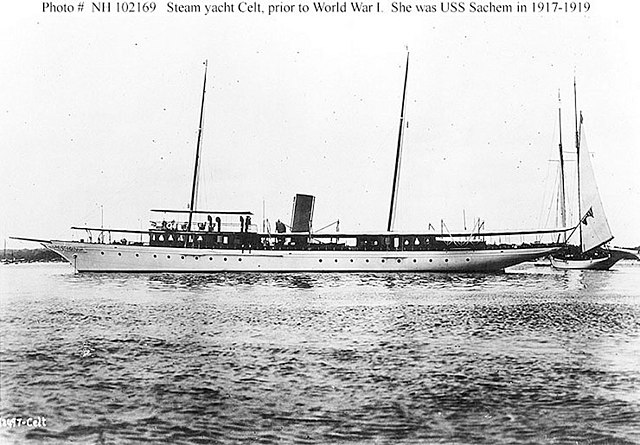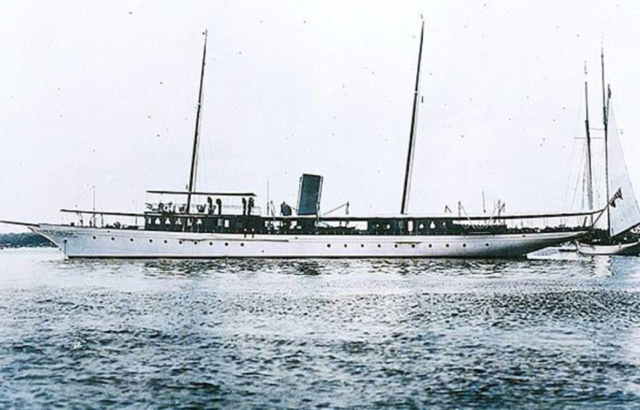Several abandoned ships can be found across the United States, but few possess a history as rich as the USS Sachem (SP-192). Known by various names, including the USS Phenakite (PYc-25), Celt, Sightseer, Circle Line V and, currently, The Ghost Ship, this early 1900s yacht has a unique legacy.
Twice acquired by the US Navy for service during World War I and II, she was transformed from a luxury vessel into one that served her country during times of conflict.
Laid down in 1901


The USS Sachem‘s story begins in 1901, when railroad engineer J. Rogers Maxwell commissioned the vessel. Built by Pusey and Jones in Wilmington, Delaware, she was launched in April 1902 under the name Celt and transited waterways as a luxury steam yacht until the United States entered World War I.
Acquired by the US Navy
With the outbreak of the conflict, the US Navy sought civilian ships for coastal defense, as the German forces were attacking supply lines between America and Europe. Celt was among those acquired for service and was renamed the USS Sachem.
Modifying the USS Sachem (SP-192) for naval service
The USS Sachem underwent significant modifications to enhance her seaworthiness, including the raising of her sides, removing her masts, sealing her ornate brass fixtures, adding navigational equipment and fitting fringing around the portholes. To prepare her for the possibility of combat in the Atlantic Ocean, she was also armed with:
- Depth charge racks
- One Ordnance QF Hotchkiss six-pounder deck gun
- Two QF three-pounder Hotchkiss deck guns
- Two light machine guns
Commandeered by Thomas Edison
During the early part of her naval service, the USS Sachem operated with the Third Maritime District, patroling the US East Coast and the Caribbean. In 1917, she was turned into a “floating laboratory” by Thomas Edison, who conducted experiments to develop effective countermeasures to the German U-boat threat.
USS Sachem (SP-192) didn’t see active combat
By the end of the First World War, the USS Sachem hadn’t engaged in active combat, nor had her crew reported any confirmed enemy U-boat sightings. Despite this, the yacht was awarded the World War I Victory Medal for her service during the conflict.
Rum running during Prohibition
After World War I, the USS Sachem was returned to Manton B. Metcalf, who’d purchased the yacht from J. Rogers Maxwell’s widow soon after his passing. Later, the vessel was sold to Philadelphia banker Roland L. Taylor, who used it as a rum runner during Prohibition.
Making money during the Great Depression
In 1932, during the early years of the Great Depression, Taylor sold the USS Sachem to Jacob Martin of Brooklyn, New York. To ensure he’d make a profit during the era’s economic downturn, he operated the yacht with dual purposes – as a deep-sea fishing vessel and as a luxury passenger ship.
Once again acquired by the US Navy
After the Japanese attack on Pearl Harbor on December 7, 1941, the US Navy, once again, needed civilian vessels to help bolster America’s defense. In February 1942, the service reacquired the USS Sachem for $65,000, sending her to Robert Jacobs, Inc. in City Island, New York, for modifications.
A host of upgrades for the now-USS Phenakite (PYc-25)
The upgrades received included new equipment; enhancements to speed, armor and visibility; and a new gray haze paint scheme. Renamed the USS Phenakite, the vessel was also armed with:
- One three-inch/23-caliber deck gun
- One Thompson submachine gun
- Two Mark VI depth charge racks
- Four M2 Browning machine guns for anti-aircraft defense
Patroling the East Coast of the United States
Under the command of Lt. John D. Lennon, the USS Phenakite patrolled the East Coast. In late 1944, she underwent additional modifications to expand her roles to convoy escort and sonar system testing, as part of the Fleet Sonar School Squadron and the Key West Squadron.
Striking the USS Phenakite (PYc-25) from the Naval Register
While the yacht didn’t see active combat, her crew was awarded both the World War II Victory Medal and the American Campaign Medal. After World War II, the USS Phenakite was decommissioned and struck from the Naval Register.
Serving as a tour boat in New York City
After World War II, Jacob Martin repurchased the USS Phenakite from the US Navy for $5,353. The yacht was then sold to the Circle Line in New York City, where she operated as a tour boat under the name Circle Line V until 1983.
Making a cameo in a Madonna music video
In 1986, Robert Miller from Cincinnati, Ohio, bought the yacht for $7,500. During the July 4 long weekend, the vessel made a cameo in Madonna‘s “Papa Don’t Preach” music video.
Following the festivities, Miller sailed her to his home on the Ohio–Kentucky border and moored the ship at the mouth of Taylor Creek in Boone County, Kentucky, where she’s remained ever since.
Left abandoned in Taylor Creek
More from us: New York’s Historic Hudson River State Hospital Has Been Decimated By Fires
Unable to afford the upkeep, Miller left the yacht to deteriorate in the water. While situated on private property, the rusting piece of naval history has become a popular attraction for both kayakers and canoeists navigating Taylor Creek. Due to her dilapidated condition, she has since earned the nickname, “The Ghost Ship.”


Leave a Comment